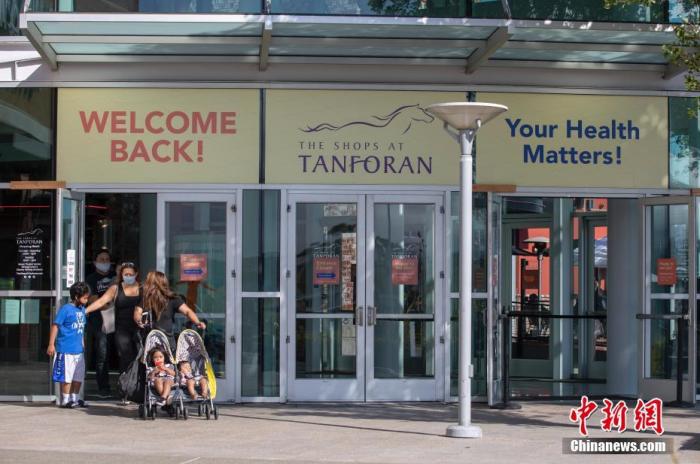China News Service, June 27. According to a Reuters report on the 26th, the number of jobless claims in the United States declined slightly last week, because the second wave of layoffs partially offset the employment growth brought about by the resumption of production and enterprises, suggesting that the labor market may It will take years to recover from the impact of the new crown epidemic. Some experts predict that the June employment report may not meet the high expectations held by the market after the May report was released.
On June 22, local time, a restaurant in Manhattan, New York, customers dine outdoors. On that day, New York City entered the second phase of restart as scheduled, and the city government expected that about 300,000 people would return to work. China News Agency reporter Liao Panshe
Bleak economic outlook
The report said that other data released on June 25 strengthened the expectation that the US economy will contract the most since the Great Depression in the second quarter. Although orders for key capital goods rebounded in May, only a small part of the previous decline was recovered. As the new crown epidemic further disrupted trade, the merchandise trade deficit widened sharply last month.
"Every aspect of the economy is not good," said Chris Rupkey, chief analyst at Mitsubishi UFJ Financial in New York. "As US states restart, companies order more equipment in May. This is good news. But in the coming months, when it comes to making new investments for the future of the United States, the second wave of outbreaks may keep companies cautious."
The Ministry of Labor announced that as of the week of June 20, the number of first-time jobless claims decreased by 60,000 after seasonal adjustment to 1.48 million. The number of people applying for unemployment benefits jumped for the first time in California. However, recently, the number of newly diagnosed cases in California, Texas and Florida has surged.
The Labor Department report also showed that 30.6 million people received unemployment benefits in the first week of June, about one-fifth of the US workforce. This report is a timely indicator of economic health.
Businesses in many US states closed in mid-March to slow the spread of the epidemic. And more than a month ago, many companies restarted. These companies are recruiting, but some other companies are also laying off staff at almost the same rate.
The US economy fell into recession in February. From manufacturing to transportation, retail, leisure and hotel industries, companies are restructuring to adapt to the huge changes in the situation, which has also led to layoffs and bankruptcy. State and local governments with tight budgets to fight the new crown epidemic are also cutting jobs.
High unemployment is weakening demand and has a ripple effect on corporate investment. In the first quarter of this year, corporate investment shrank the most since mid-2009.
A report from the Ministry of Commerce showed that after a 6.5% decline in April, non-defense capital goods orders excluding aircraft increased by 2.3% in May. These so-called core capital goods orders are 5.6% lower than the level before the outbreak.
The surge in new crown infections threatens investment in companies that have just improved. The epidemic is also disrupting the circulation of commodities. The U.S. Department of Commerce said in another report that the merchandise trade deficit increased by 5.1% in May to $7.43 billion. Exports fell by 5.8% and imports fell by 1.2%. As imports fell again, retailers and wholesalers reduced their inventories.
Economists predict that the second-quarter GDP may fall at an annual rate of up to 46%. In the first quarter of 2020, the US economy contracted at a rate of 5%, which was the worst recession since the Great Depression.
On June 19 local time, a large shopping mall in San Mateo County, California, opened its doors. At present, California is restarting its economy and entering the third stage. As long as the county permits, high-risk facilities such as movie theaters, restaurants, and large shopping centers can be reopened. China News Service reporter Liu Guanguan
Hard to reach high expectations
As of the week of June 13, the number of jobless claims decreased by 767,000 to 19.52 million, a decrease from the record high of 24.912 million at the beginning of May.
Economists attribute this to the U.S. government's salary guarantee program, which provides loans to companies that are free of repayment if they are used to pay wages. The week covered by the unemployment benefits data is within the cycle of the government’s June unemployment rate survey.
Since March, the unemployment rate has a downward trend, because people mistakenly classify themselves as "having a job but not currently working." Without this problem, the unemployment rate in May will be as high as 16.3% instead of 13.3%. The unemployment rate in April hit a peak of about 19.7%.
The US government has expanded its eligibility for unemployment benefits to include self-employed people and independent contractors affected by the epidemic, covering unemployment, reduced working hours and reduced wages.
These applications are not included in the normal state unemployment insurance, so regular state unemployment benefits application data underestimates the degree of downturn in the labor market. At present, about 33 million people have applied for welfare through various projects.
"These data indicate that the June employment report may not meet the high expectations held by the market after the May report was released," said Andrew Stettner, senior researcher at the Think Foundation Century Foundation (The Century Foundation).

